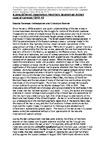A Very Different Experience: Merchant Seamen on British Coastal Convoys 1940-45'
| dc.contributor.author | Bennett, George | |
| dc.contributor.editor | Rosendahl BT | |
| dc.date.accessioned | 2018-11-01T08:46:54Z | |
| dc.date.available | 2018-11-01T08:46:54Z | |
| dc.date.issued | 2018 | |
| dc.identifier.other | 2 | |
| dc.identifier.uri | http://hdl.handle.net/10026.1/12707 | |
| dc.description.abstract |
Coastal Convoys: Introduction and Literature Review Since the early 1940s academic and public understandings of the war at sea in Europe have been dominated by the struggle for control of the Atlantic sealanes. Images and narratives of U-boats versus the escorted, seried columns of merchant ships in carefully controlled and closely fought convoy actions in the Atlantic proliferate in media representations. The British Government’s belated decision in 2012 to award veterans of the Russian convoys a special campaign medal in the form of the Arctic Star had only minimal impact on public perceptions of the geographical confines of Britain’s sea war. 1 While within academic opinion there is a very firm understanding that the war at sea, especially the merchant seamen’s war, was very different in the Atlantic, as opposed to the Mediterranean, Pacific and Arctic theatres of operation, one area of convoy operations in the Second World War continues to be seriously overlooked by both academics and the general public: the convoys which operated in UK coastal waters. While the Atlantic justifiably has taken the lion’s share of public and academic attention (it was on this critical and closely contested campaign that Britain’s survival depended from 1939 to 1945) the significance of the coastal convoys merits greater attention than they have hitherto received. As Richard Woodman has commented the coastal convoys remain ‘one of the many disregarded elements in Britain’s maritime struggle’.2 The lack of academic inquiry into the wartime coastal convoys constitutes a surprising and very serious gap in the literature of the Second World War, the history of the British Merchant Navy and the narratives of many of the maritime communities along the East Coast of the United Kingdom. Put simply the coastal convoys were equally critical to Britain’s survival as the Atlantic convoys from 1940 to 1944. They produced a very different set of strategic and tactical problems for both sides in the war at sea that has not been studied in any depth. In turn, the tactical and strategic problems of coastal convoys meant a significantly different wartime experiences for the merchant navy crews trying to fight their ships through to destinations on the South and East Coasts of the United Kingdom. As we try to refine and add detail to our understanding of the merchant seamen’s experience in the Second World War, the nature of the war at sea, and the life of seafarers in those communities that produced the coaster crews, it is essential to interrogate and establish such differences in substantially greater depth. The nature of the war at sea in European waters cannot be understood without a fuller appreciation of the role and importance of coastal convoys. | |
| dc.format.extent | 47-74 | |
| dc.language.iso | en | |
| dc.publisher | Cappelen Damm, Akademisk, | |
| dc.relation.ispartof | Allied Merchant Seafarers in the Second World War | |
| dc.title | A Very Different Experience: Merchant Seamen on British Coastal Convoys 1940-45' | |
| dc.type | chapter | |
| plymouth.organisational-group | /Plymouth | |
| plymouth.organisational-group | /Plymouth/Faculty of Arts, Humanities and Business | |
| plymouth.organisational-group | /Plymouth/REF 2021 Researchers by UoA | |
| plymouth.organisational-group | /Plymouth/REF 2021 Researchers by UoA/UoA28 History | |
| plymouth.organisational-group | /Plymouth/Users by role | |
| plymouth.organisational-group | /Plymouth/Users by role/Academics | |
| dc.publisher.place | Oslo | |
| dc.rights.embargoperiod | Not known | |
| rioxxterms.licenseref.uri | http://www.rioxx.net/licenses/all-rights-reserved | |
| rioxxterms.type | Book chapter |


